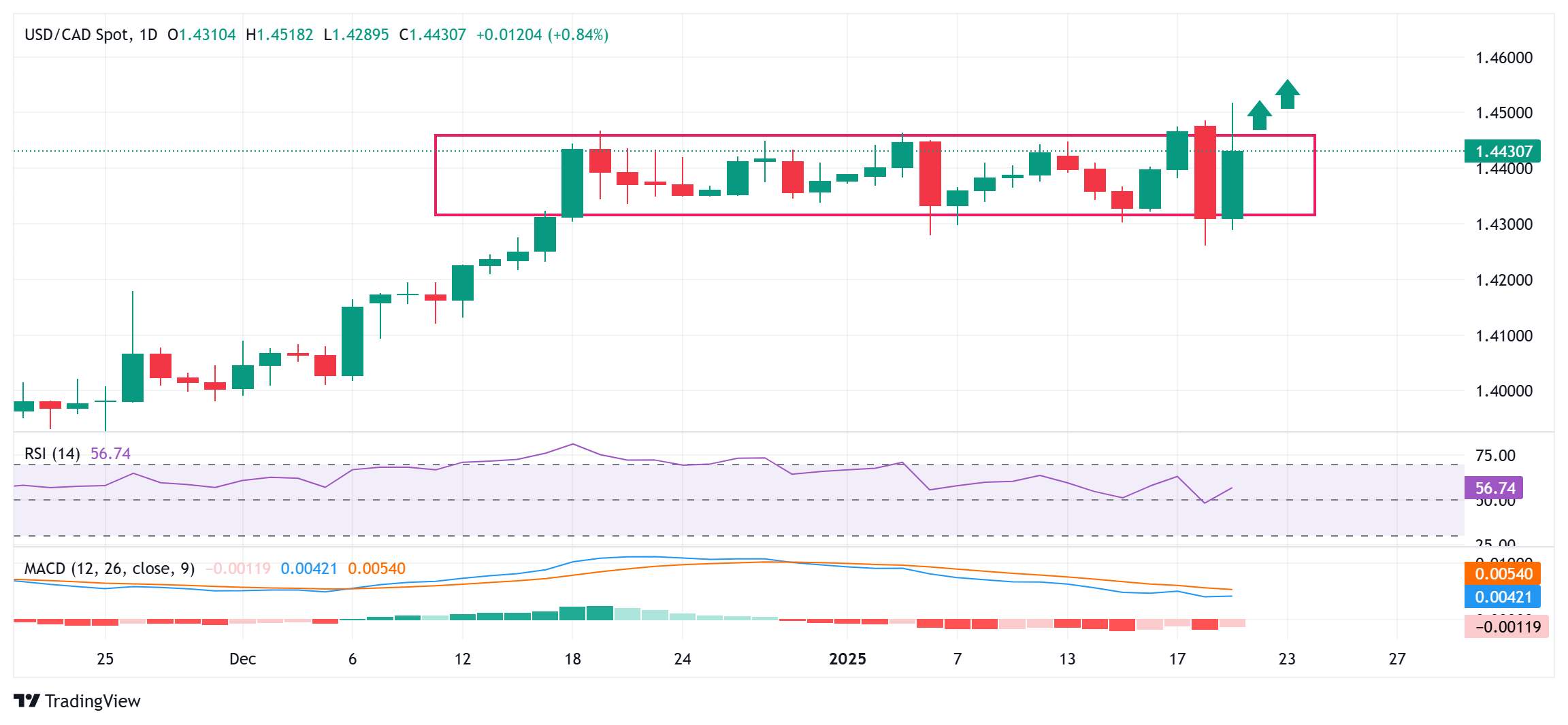- USD/CAD spikes to a fresh multi-year top on Tuesday in reaction to Trump’s tariff remarks.
- A modest USD recovery from a two-week low further contributes to the strong move up.
- Declining US bond yields caps the USD and spot prices amid an uptick in Crude Oil prices.
- Traders also seem reluctant and opt to wait for the release of the Canadian CPI report.
The USD/CAD pair catches aggressive bids following the previous day's slump to over one-month low and touches its highest level since March 2020 in reaction to US President Donald Trump's remarks. Hours after taking the oath, Trump said that he was mulling over additional tariffs of around 25% on imports from Canada and Mexico starting from February 1. Trump accused the two major US trading partners of failing to stop illegal immigration and narcotics, and called Canada “a very bad abuser”. The announcement fueled concerns about the potential negative impact on the Canadian economy, which might force the Bank of Canada (BoC) to cut interest rates further. Apart from this, the recent pullback in Crude Oil prices from the highest level since July 2024, weighed on the commodity-linked Loonie.
The US Dollar (USD), on the other hand, stages a modest bounce from a two-week low touched on Monday amid expectations that Trump's protectionist policies would boost inflation and force the Federal Reserve (Fed) to stick to its hawkish stance. This turns out to be another factor that provides an additional boost to the USD/CAD pair and contributes to the strong move-up. Investors, meanwhile, have been betting that the Fed will lower borrowing costs twice this year on the back of signs of easing inflationary pressures. This, along with the global flight to safety, leads to a further decline in the US Treasury bond yields, which keeps a lid on the USD and the currency pair. Traders also seem reluctant and opt to wait for the release of the latest consumer inflation figures from Canada, due later today.
Investors are currently pricing in about a 75% chance that the BoC may lower its benchmark interest rate by 25 basis points on January 29. A softer Canadian Consumer Price Index (CPI) for December would reinforce market expectations and exert additional downward pressure on the CAD. In contrast, the immediate reaction to a stronger CPI print is likely to be limited amid the divergent Fed-BoC policy outlook and concerns about a possible economic fallout from Trump's trade policies. This, in turn, suggests that the path of least resistance for the USD/CAD pair is to the upside and any corrective pullback could be seen as an opportunity for bullish traders.
USD/CAD daily chart
Technical Outlook
The USD/CAD pair has been oscillating in a familiar range over the past month or so. Against the backdrop of a strong move up from the September 2024 low, this might still be categorized as a bullish consolidation phase. Moreover, technical indicators on the daily chart – though have been losing positive traction – are still holding in positive territory. This further validates the near-term constructive outlook for the USD/CAD pair. That said, it will still be prudent to wait for sustained strength and acceptance above the 1.4465-1.4470 supply zone before positioning for further gains. This is followed by the 1.4500 psychological mark and the 1.4515 area, or a multi-year peak, above which spot prices might aim to conquer the 1.4600 round figure.
On the flip side, any subsequent pullback is likely to find decent support near the 1.4400 mark. A further slide could be seen as a buying opportunity near the 1.4335 region, which, in turn, should help limit the downside for the USD/CAD pair near the 1.4300 mark. This is followed by the monthly swing low, around the 1.4260 area. A convincing break below the latter could shift the bias in favor of bearish traders and pave the way for a deeper corrective decline.
Information on these pages contains forward-looking statements that involve risks and uncertainties. Markets and instruments profiled on this page are for informational purposes only and should not in any way come across as a recommendation to buy or sell in these assets. You should do your own thorough research before making any investment decisions. FXStreet does not in any way guarantee that this information is free from mistakes, errors, or material misstatements. It also does not guarantee that this information is of a timely nature. Investing in Open Markets involves a great deal of risk, including the loss of all or a portion of your investment, as well as emotional distress. All risks, losses and costs associated with investing, including total loss of principal, are your responsibility. The views and opinions expressed in this article are those of the authors and do not necessarily reflect the official policy or position of FXStreet nor its advertisers. The author will not be held responsible for information that is found at the end of links posted on this page.
If not otherwise explicitly mentioned in the body of the article, at the time of writing, the author has no position in any stock mentioned in this article and no business relationship with any company mentioned. The author has not received compensation for writing this article, other than from FXStreet.
FXStreet and the author do not provide personalized recommendations. The author makes no representations as to the accuracy, completeness, or suitability of this information. FXStreet and the author will not be liable for any errors, omissions or any losses, injuries or damages arising from this information and its display or use. Errors and omissions excepted.
The author and FXStreet are not registered investment advisors and nothing in this article is intended to be investment advice.
Recommended Content
Editors’ Picks

EUR/USD holds gains below 1.1000 ahead of US CPI release
EUR/USD is tirmimng gains while below 1.1000 in the European session on Thursday. The Euro gains on the German coalition deal and Trump's 90-day pause on reciprocal tariffs. Meanwhile, the US Dollar finds demand on profit-booknig ahead of the US CPI data release.

GBP/USD trades firm above 1.2850, US CPI data awaited
GBP/USD sustained the rebound above 1.2850 in European trading hours on Thursday. The British Pound capitalizes on risk appetite, courtesy of Trump's tariff pause, allowing the pair to recover ground. But further upside hinges on the US CPI data and US-Sino trade updates.

Gold price rallies further beyond $3,100; eyes all-time high amid US-China tariff war
Gold price continues to attract safe-haven flows amid rising US-China trade tensions. Bets for multiple Fed rate cuts weigh on the USD and also benefit the precious metal. A solid recovery in the risk sentiment fails to undermine the safe-haven XAU/USD pair.

XRP back above $2 liquidating $18M in short positions, will the rally continue?
Ripple seeks support above $2.0020 on Thursday after gaining 14% in the past 24 hours. The token trades at $2.0007 at the time of writing, reflecting growing bullish sentiment across global markets.

Tariff rollercoaster continues as China slapped with 104% levies
The reaction in currencies has not been as predictable. The clear winners so far remain the safe-haven Japanese yen and Swiss franc, no surprises there, while the euro has also emerged as a quasi-safe-haven given its high liquid status.

The Best brokers to trade EUR/USD
SPONSORED Discover the top brokers for trading EUR/USD in 2025. Our list features brokers with competitive spreads, fast execution, and powerful platforms. Whether you're a beginner or an expert, find the right partner to navigate the dynamic Forex market.
